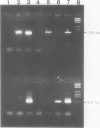Abstract
AIMS--To use the polymerase chain reaction (PCR) to detect Chlamydia pneumoniae and Chlamydia psittaci in sputum samples. METHODS--A nested PCR was developed, the first stage of which amplified DNA from both C pneumoniae and C psittaci while the second stage targeted specifically at C pneumoniae, allowing the two species to be differentiated. The primers were designed not to amplify sequences from C trachomatis. A panel of 26 sputum samples from patients with community acquired pneumonia evaluated previously by enzyme linked immunosorbent assay (ELISA), direct immunofluorescence (DIF), and culture was tested blind by PCR. Most of these specimens also had accompanying serial serum samples which were tested for species specific antibodies using microimmunofluorescence (micro-IF). RESULTS--PCR detected C pneumoniae DNA in 10 of the 26 samples and C psittaci DNA in four. There was good concordance between ELISA, DIF, micro-IF and PCR in the C pneumoniae group. Two of the C psittaci identified by PCR were labelled C pneumoniae by DIF but the PCR results were supported by serology or a history of bird contact. Of the PCR negative group: six were true negative results; two contained C trachomatis. There were four discrepant results. CONCLUSIONS--The data suggest that PCR is effective in the detection of C pneumoniae. The sensitivity for C psittaci is inevitably lower due to the strategy taken but specificity seemed to be good.
Full text
PDF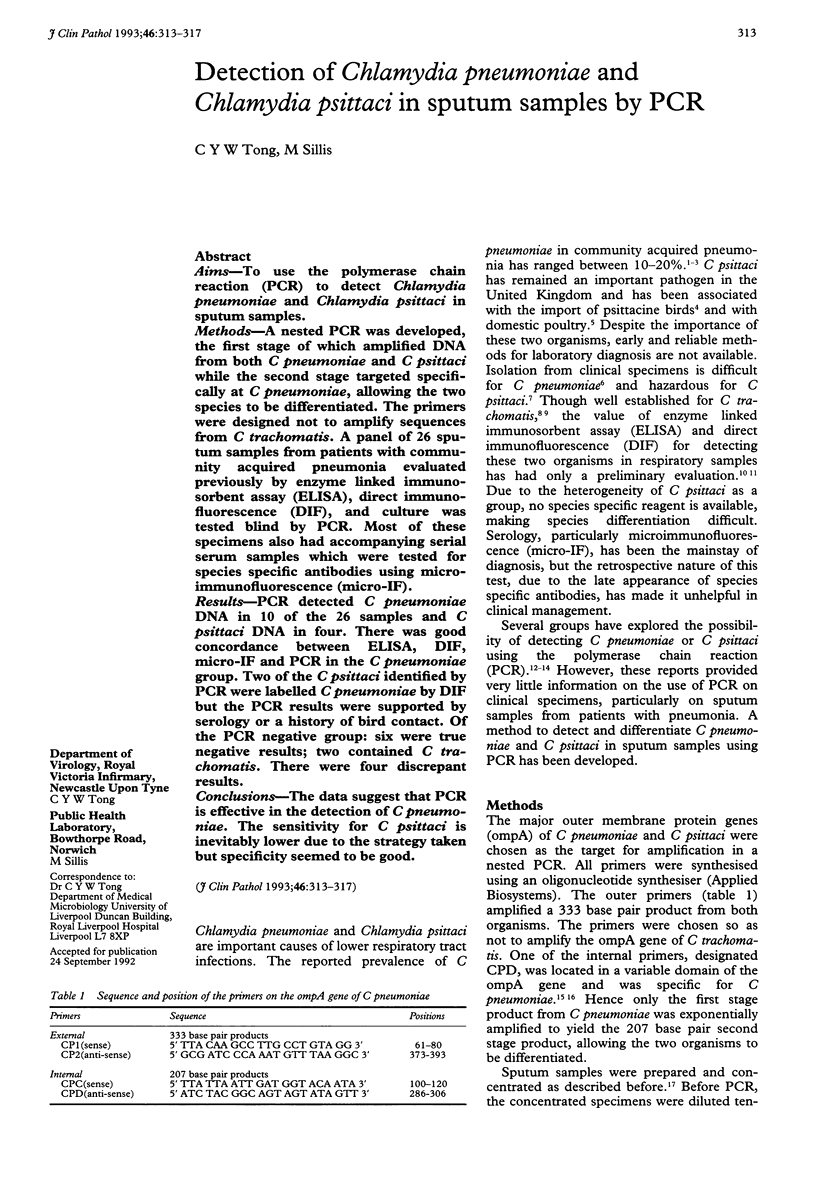
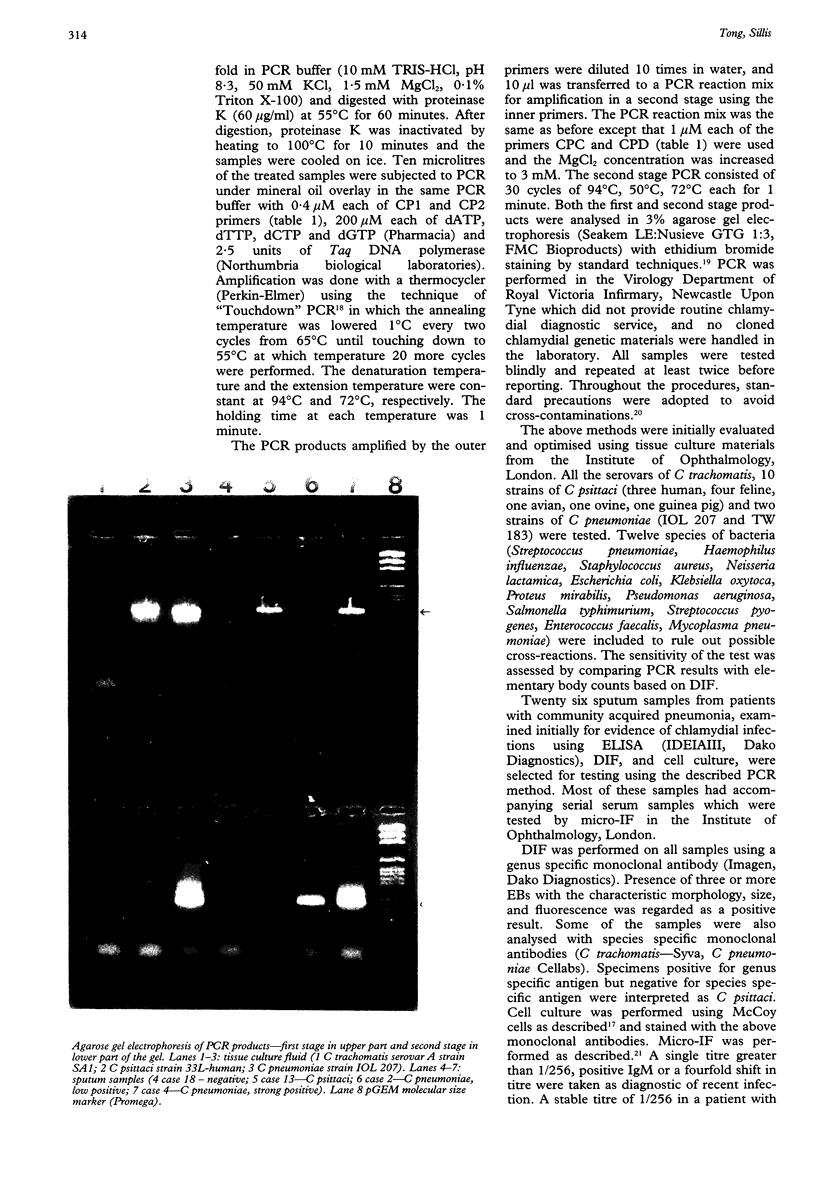
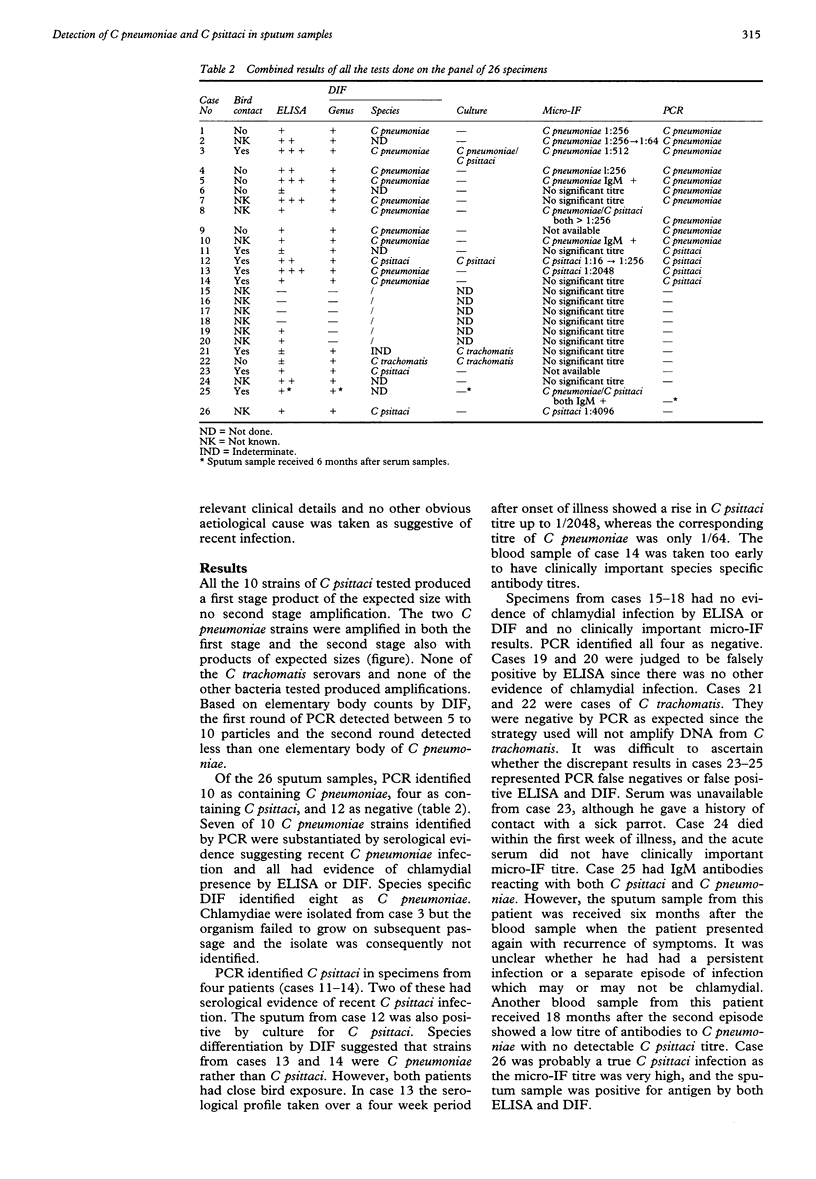
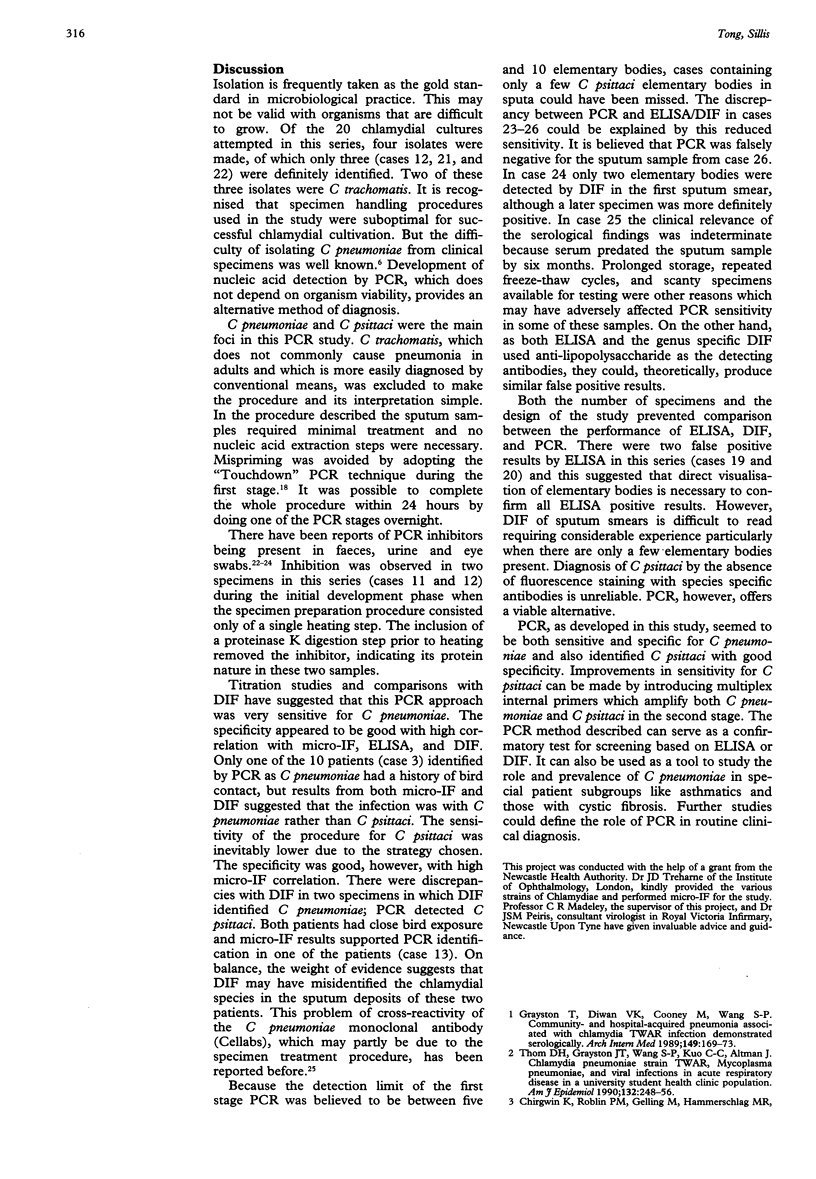
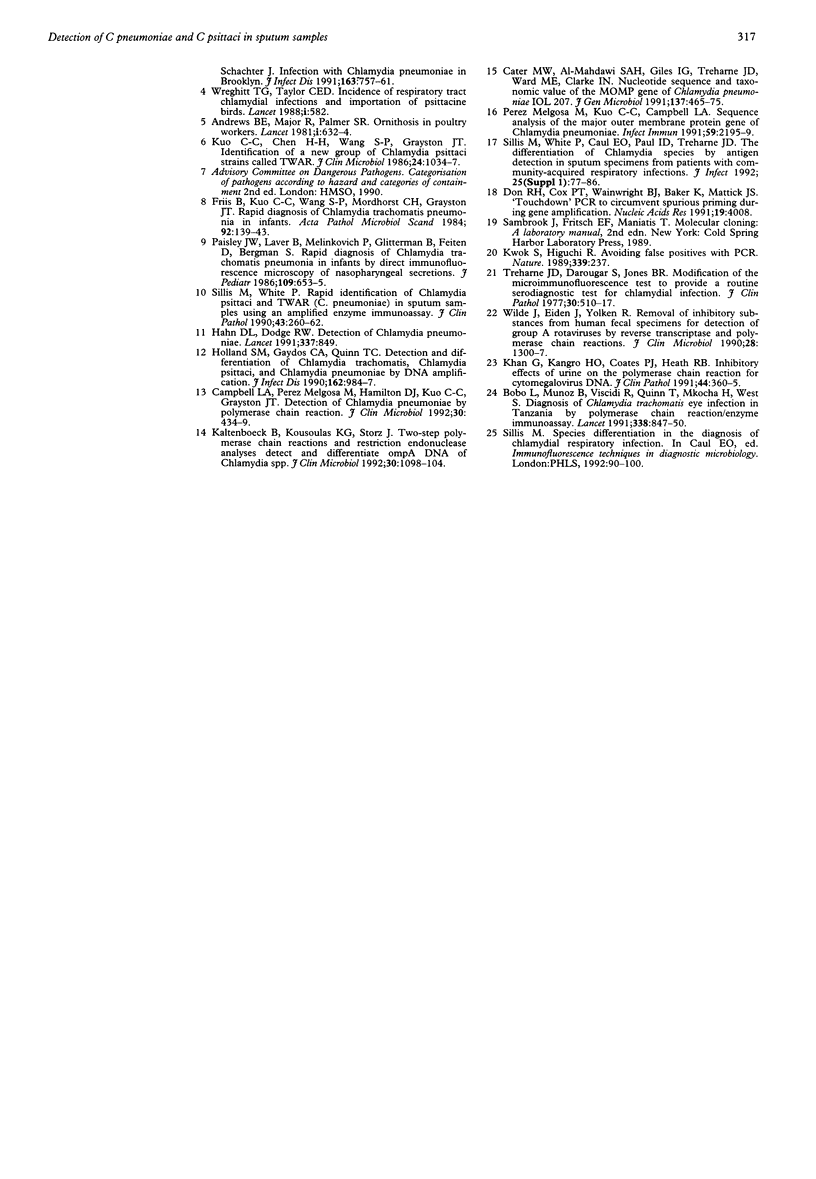
Images in this article
Selected References
These references are in PubMed. This may not be the complete list of references from this article.
- Andrews B. E., Major R., Palmer S. R. Ornithosis in poultry workers. Lancet. 1981 Mar 21;1(8221):632–634. doi: 10.1016/s0140-6736(81)91552-x. [DOI] [PubMed] [Google Scholar]
- Bobo L., Munoz B., Viscidi R., Quinn T., Mkocha H., West S. Diagnosis of Chlamydia trachomatis eye infection in Tanzania by polymerase chain reaction/enzyme immunoassay. Lancet. 1991 Oct 5;338(8771):847–850. doi: 10.1016/0140-6736(91)91502-l. [DOI] [PubMed] [Google Scholar]
- Campbell L. A., Perez Melgosa M., Hamilton D. J., Kuo C. C., Grayston J. T. Detection of Chlamydia pneumoniae by polymerase chain reaction. J Clin Microbiol. 1992 Feb;30(2):434–439. doi: 10.1128/jcm.30.2.434-439.1992. [DOI] [PMC free article] [PubMed] [Google Scholar]
- Carter M. W., al-Mahdawi S. A., Giles I. G., Treharne J. D., Ward M. E., Clark I. N. Nucleotide sequence and taxonomic value of the major outer membrane protein gene of Chlamydia pneumoniae IOL-207. J Gen Microbiol. 1991 Mar;137(3):465–475. doi: 10.1099/00221287-137-3-465. [DOI] [PubMed] [Google Scholar]
- Chirgwin K., Roblin P. M., Gelling M., Hammerschlag M. R., Schachter J. Infection with Chlamydia pneumoniae in Brooklyn. J Infect Dis. 1991 Apr;163(4):757–761. doi: 10.1093/infdis/163.4.757. [DOI] [PubMed] [Google Scholar]
- Don R. H., Cox P. T., Wainwright B. J., Baker K., Mattick J. S. 'Touchdown' PCR to circumvent spurious priming during gene amplification. Nucleic Acids Res. 1991 Jul 25;19(14):4008–4008. doi: 10.1093/nar/19.14.4008. [DOI] [PMC free article] [PubMed] [Google Scholar]
- Friis B., Kuo C. C., Wang S. P., Mordhorst C. H., Grayston J. T. Rapid diagnosis of Chlamydia trachomatis pneumonia in infants. Acta Pathol Microbiol Immunol Scand B. 1984 Jun;92(3):139–143. doi: 10.1111/j.1699-0463.1984.tb02808.x. [DOI] [PubMed] [Google Scholar]
- Grayston J. T., Diwan V. K., Cooney M., Wang S. P. Community- and hospital-acquired pneumonia associated with Chlamydia TWAR infection demonstrated serologically. Arch Intern Med. 1989 Jan;149(1):169–173. [PubMed] [Google Scholar]
- Hahn D. L., Dodge R. W. Detection of Chlamydia pneumoniae. Lancet. 1991 Apr 6;337(8745):849–849. doi: 10.1016/0140-6736(91)92553-e. [DOI] [PubMed] [Google Scholar]
- Holland S. M., Gaydos C. A., Quinn T. C. Detection and differentiation of Chlamydia trachomatis, Chlamydia psittaci, and Chlamydia pneumoniae by DNA amplification. J Infect Dis. 1990 Oct;162(4):984–987. doi: 10.1093/infdis/162.4.984. [DOI] [PubMed] [Google Scholar]
- Kaltenboeck B., Kousoulas K. G., Storz J. Two-step polymerase chain reactions and restriction endonuclease analyses detect and differentiate ompA DNA of Chlamydia spp. J Clin Microbiol. 1992 May;30(5):1098–1104. doi: 10.1128/jcm.30.5.1098-1104.1992. [DOI] [PMC free article] [PubMed] [Google Scholar]
- Kuo C. C., Chen H. H., Wang S. P., Grayston J. T. Identification of a new group of Chlamydia psittaci strains called TWAR. J Clin Microbiol. 1986 Dec;24(6):1034–1037. doi: 10.1128/jcm.24.6.1034-1037.1986. [DOI] [PMC free article] [PubMed] [Google Scholar]
- Kwok S., Higuchi R. Avoiding false positives with PCR. Nature. 1989 May 18;339(6221):237–238. doi: 10.1038/339237a0. [DOI] [PubMed] [Google Scholar]
- Paisley J. W., Lauer B. A., Melinkovich P., Gitterman B. A., Feiten D. J., Berman S. Rapid diagnosis of Chlamydia trachomatis pneumonia in infants by direct immunofluorescence microscopy of nasopharyngeal secretions. J Pediatr. 1986 Oct;109(4):653–655. doi: 10.1016/s0022-3476(86)80232-3. [DOI] [PubMed] [Google Scholar]
- Perez Melgosa M., Kuo C. C., Campbell L. A. Sequence analysis of the major outer membrane protein gene of Chlamydia pneumoniae. Infect Immun. 1991 Jun;59(6):2195–2199. doi: 10.1128/iai.59.6.2195-2199.1991. [DOI] [PMC free article] [PubMed] [Google Scholar]
- Sillis M., White P., Caul E. O., Paul I. D., Treharne J. D. The differentiation of Chlamydia species by antigen detection in sputum specimens from patients with community-acquired acute respiratory infections. J Infect. 1992 Jul;25 (Suppl 1):77–86. doi: 10.1016/0163-4453(92)92130-b. [DOI] [PubMed] [Google Scholar]
- Sillis M., White P. Rapid identification of Chlamydia psittaci and TWAR (C pneumoniae) in sputum samples using an amplified enzyme immunoassay. J Clin Pathol. 1990 Mar;43(3):260–260. doi: 10.1136/jcp.43.3.260-a. [DOI] [PMC free article] [PubMed] [Google Scholar]
- Thom D. H., Grayston J. T., Wang S. P., Kuo C. C., Altman J. Chlamydia pneumoniae strain TWAR, Mycoplasma pneumoniae, and viral infections in acute respiratory disease in a university student health clinic population. Am J Epidemiol. 1990 Aug;132(2):248–256. doi: 10.1093/oxfordjournals.aje.a115654. [DOI] [PubMed] [Google Scholar]
- Treharne J. D., Darougar S., Jones B. R. Modification of the microimmunofluorescence test to provide a routine serodiagnostic test for chlamydial infection. J Clin Pathol. 1977 Jun;30(6):510–517. doi: 10.1136/jcp.30.6.510. [DOI] [PMC free article] [PubMed] [Google Scholar]
- Wilde J., Eiden J., Yolken R. Removal of inhibitory substances from human fecal specimens for detection of group A rotaviruses by reverse transcriptase and polymerase chain reactions. J Clin Microbiol. 1990 Jun;28(6):1300–1307. doi: 10.1128/jcm.28.6.1300-1307.1990. [DOI] [PMC free article] [PubMed] [Google Scholar]
- Wreghitt T. G., Taylor C. E. Incidence of respiratory tract chlamydial infections and importation of psittacine birds. Lancet. 1988 Mar 12;1(8585):582–582. doi: 10.1016/s0140-6736(88)91368-2. [DOI] [PubMed] [Google Scholar]



